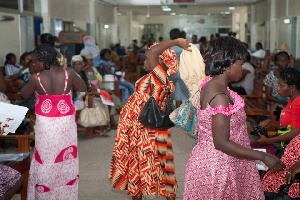There are over 12 million outpatient visits a year in Ghana. Among these, over 5million are malaria cases, 800,000 are respiratory infections, 500,000 are diarrhea and 300,000 are hypertension.
These figures were disclosed by the Minister of Health, Major (RT) Courage Quashiga at the launch of the National Platform for disaster risk reduction in Ghana.
In a speech, the Health Minister noted that, the figures represent only those cases seen at the health institutions. "Only a part of the whole picture; the full picture is worse", he said.
Major (Rtd) Courage Quashiga said a study by his Ministry on who gets what type of illness, where and when, reveals that the poor, the uneducated, infants and the elderly carry a greater burden of these diseases than the well-to-do, the educated, older children and able bodied person.
He said those in the northern savannah zones have a worse health status than those in the southern forest or coastal zones.
The Health Minister noted that some diseases are seasonal. This he said relates to climate and other physical conditions.
"For example, the incidence and prevalence of malaria is closely linked to rainfall and ecological zones, cholera is less prevalent in northern Ghana, while respiratory diseases and cerebra-spinal meningitis (CSM) are most common in dry areas", he explained.
Lamenting on some of the challenges facing the Health Ministry, Major Quashiga said the biggest challenge facing the Ministry is three-fold.
"First to re-orient health workers in particular and the general population to pay more attention to action and services that promote health, prevent illness and rehabilitate the injured.
The second is to identify and work closely with ministries, agencies, organizations and individuals and communities whose activities and core functions maintain health and prevent illness and the last challenge is to explore and find evidence for the ways in which these risk factors actually work to influence health so that we can adapt your measures better".
He noted that the way Ghanaians can reduce or better cope with disaster induced by health hazards are: "Making health hazards management a priority in disaster policy by adopting a multi-hazards approach that incorporates epidemics and other natural hazards and re-orienting the current focus on post-epidemic response towards prevention in managing health effects of disaster, including through health early warning systems".
He also urged Ghanaians to cooperate to make the National Health Insurance Scheme successful to help in spreading risks associated with health hazards.
The Minister for the Interior, Mr. Albert Kan-Dapaah who also spoke at the launch warned that "disaster" could be the greatest challenge in Ghana's quest to attain the UN's Millennium Development Goal (MDG).
He said the government regards issues of disaster risk as core development concerns.
"This explains why disaster management has been given so much prominence as a focal; area in Ghana's medium-term development strategies, the Ghana Poverty Reduction Strategy (GPRS) and the current Growth and Poverty Reduction Strategy (GPRS II) Our concern thus goes beyond making disaster management a focal area of the GPRS II. It extends to making the entire GPRS and the disaster risk reduction approach mutually supportive".
He explained that since the policy and institutional framework is crucial in engendering this public awareness and improving response to disaster, the government has put in place an inter-ministerial national disaster management committee, responsible for the overall implementation of the national disaster management policy, and also an agency backed by the requisite legislation, to implement an integrated national disaster management plan.
"To sustain the voluntary spirit, and as part of our changing focus on reducing vulnerability to threats to livelihoods, we have embarked on the approach of emphasizing livelihood risk management through employment generation and poverty alleviation intervention" he disclosed. A major example of this he said is a new natural resource management programme of nursing tree seedlings for income by volunteers at the local level.
"This provides the communities with a means of livelihood while they produce tree seedlings which would help in our national programme for protecting the environment", he said.
He however noted that despite these efforts by the government to manage disaster, there are several gaps and weaknesses.
He mentioned some of the weaknesses as "improving compliance with technical measures, such as land use planning and development controls, codes and standards; learning to utilize post-disaster situation as opportunity to reduce future disaster risk and improving and re-orient the human resource base of the disaster management structures".
Mr. Kan Dapaah told NADMO and other bodies deliberating on the national platform for disaster risk reduction in Ghana to articulate what can be done to close those gaps that are hindering government's policies.
He urged Ghanaians to see disaster management as a multi-disciplinary and inter-institutional undertaking that calls for cooperation and coordination among all stakeholders, partners and citizens.
Health News of Tuesday, 16 May 2006
Source: adm













